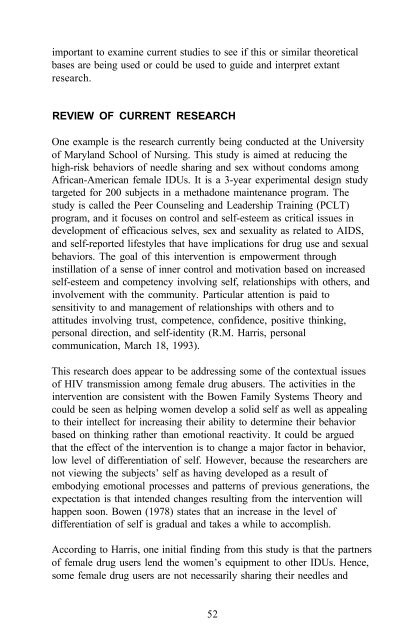The Context of HIV Risk Among Drug Users and Their Sexual Partners
The Context of HIV Risk Among Drug Users and Their Sexual Partners
The Context of HIV Risk Among Drug Users and Their Sexual Partners
Create successful ePaper yourself
Turn your PDF publications into a flip-book with our unique Google optimized e-Paper software.
important to examine current studies to see if this or similar theoretical<br />
bases are being used or could be used to guide <strong>and</strong> interpret extant<br />
research.<br />
REVIEW OF CURRENT RESEARCH<br />
One example is the research currently being conducted at the University<br />
<strong>of</strong> Maryl<strong>and</strong> School <strong>of</strong> Nursing. This study is aimed at reducing the<br />
high-risk behaviors <strong>of</strong> needle sharing <strong>and</strong> sex without condoms among<br />
African-American female IDUs. It is a 3-year experimental design study<br />
targeted for 200 subjects in a methadone maintenance program. <strong>The</strong><br />
study is called the Peer Counseling <strong>and</strong> Leadership Training (PCLT)<br />
program, <strong>and</strong> it focuses on control <strong>and</strong> self-esteem as critical issues in<br />
development <strong>of</strong> efficacious selves, sex <strong>and</strong> sexuality as related to AIDS,<br />
<strong>and</strong> self-reported lifestyles that have implications for drug use <strong>and</strong> sexual<br />
behaviors. <strong>The</strong> goal <strong>of</strong> this intervention is empowerment through<br />
instillation <strong>of</strong> a sense <strong>of</strong> inner control <strong>and</strong> motivation based on increased<br />
self-esteem <strong>and</strong> competency involving self, relationships with others, <strong>and</strong><br />
involvement with the community. Particular attention is paid to<br />
sensitivity to <strong>and</strong> management <strong>of</strong> relationships with others <strong>and</strong> to<br />
attitudes involving trust, competence, confidence, positive thinking,<br />
personal direction, <strong>and</strong> self-identity (R.M. Harris, personal<br />
communication, March 18, 1993).<br />
This research does appear to be addressing some <strong>of</strong> the contextual issues<br />
<strong>of</strong> <strong>HIV</strong> transmission among female drug abusers. <strong>The</strong> activities in the<br />
intervention are consistent with the Bowen Family Systems <strong>The</strong>ory <strong>and</strong><br />
could be seen as helping women develop a solid self as well as appealing<br />
to their intellect for increasing their ability to determine their behavior<br />
based on thinking rather than emotional reactivity. It could be argued<br />
that the effect <strong>of</strong> the intervention is to change a major factor in behavior,<br />
low level <strong>of</strong> differentiation <strong>of</strong> self. However, because the researchers are<br />
not viewing the subjects’ self as having developed as a result <strong>of</strong><br />
embodying emotional processes <strong>and</strong> patterns <strong>of</strong> previous generations, the<br />
expectation is that intended changes resulting from the intervention will<br />
happen soon. Bowen (1978) states that an increase in the level <strong>of</strong><br />
differentiation <strong>of</strong> self is gradual <strong>and</strong> takes a while to accomplish.<br />
According to Harris, one initial finding from this study is that the partners<br />
<strong>of</strong> female drug users lend the women’s equipment to other IDUs. Hence,<br />
some female drug users are not necessarily sharing their needles <strong>and</strong><br />
52
















